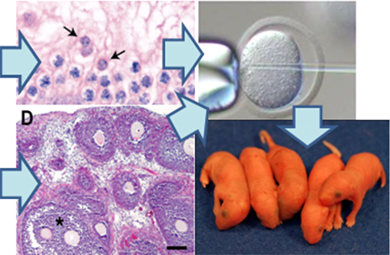 |
BRC Current Technology April 2012 |
4. Ectopic Germ Cell TransplantationProduction of functional gametes under the
|
|
 |
 |
| Mammalian germ cells first emerge from embryonic epiblast cells as primordial germ cells (PGCs). PGCs undergo dynamic genetic (i.e., meiosis) and epigenetic changes that are quite different from those of somatic cells. These changes are thought to be under the strict control of autonomous systems and from external milieu and, therefore, the complex series of developmental events in PGCs should proceed precisely in a spatially and temporally dependent manner. This is the one of the major causes of difficulty in producing functional gametes from PGCs under entirely in vitro condition. However, if PGCs can develop ectopically in adult animals, the technique would accelerate their experimental manipulation in vitro in the field of germ cell biology. We found that when PGCs isolated from 12.5 dpc mouse embryos of both sexes were transplanted together with gonadal somatic cells into the kidney capsules, testis- and ovary-like tissues developed within about 4 weeks. Inside these tissues, there were many PGC-derived developing germ cells, which were proven to be functional with the aid of assisted reproductive technology such as in vitro maturation of oocytes and microinsemination (ICSI). Thus, PGC development is specially and temporally more flexible than we imagined before. The key to the successful development and survival of PGCs was most likely the coexistence of a set of appropriate somatic cells. As the preparation of somatic cell suspensions from fetal gonads is relatively easy, this transplantation system would be applicable to genetic conservation of invaluable animal resources and to the experimental model for in vitro-production of germ cells from ES cells or iPS cells. | |
| Reference: Matoba et al., Biol. Reprod. 84, 631-638 (2011) | |
| Comment in: Roelen BA., Biol. Reprod. 84, 619-620 (2011) | |




